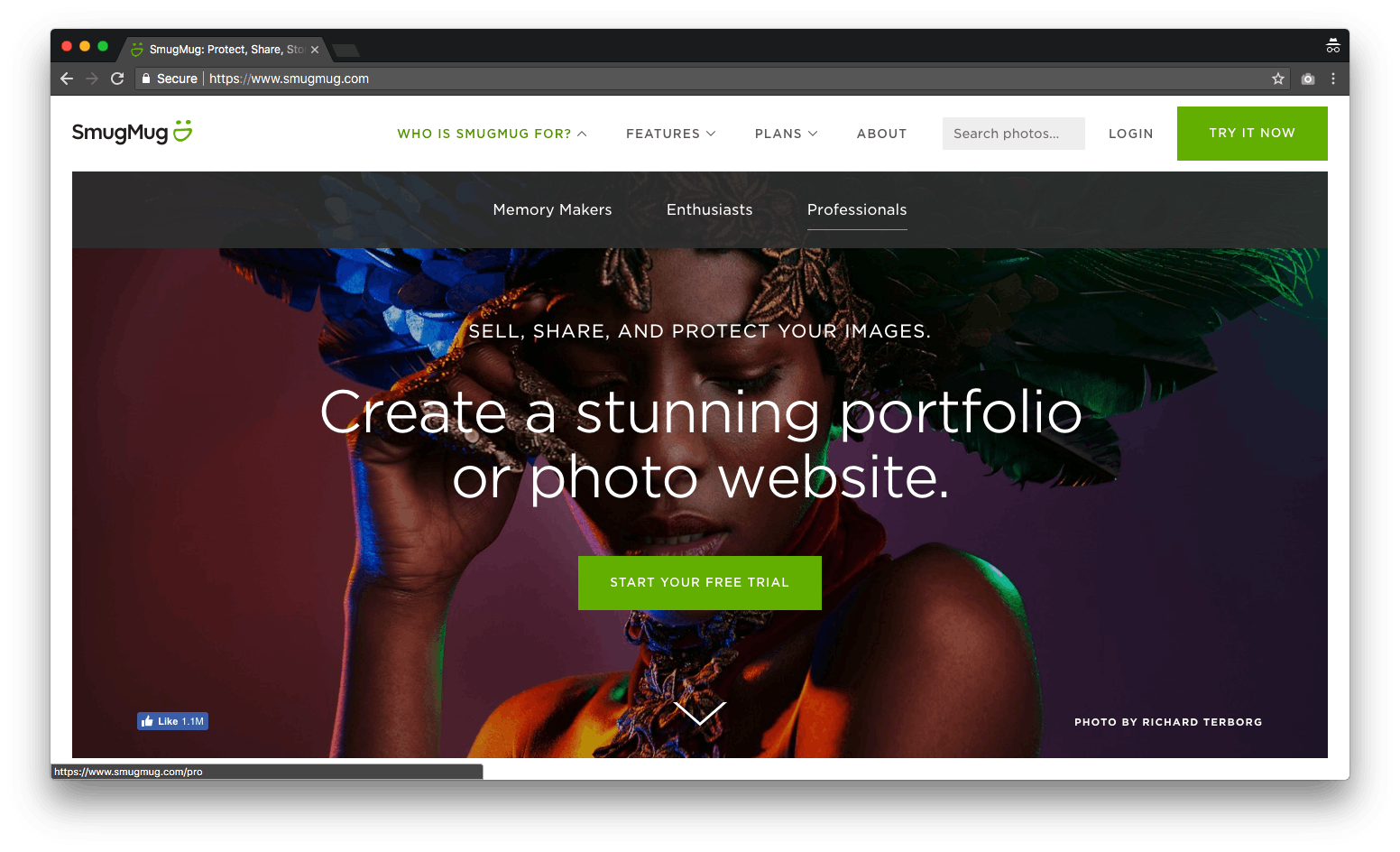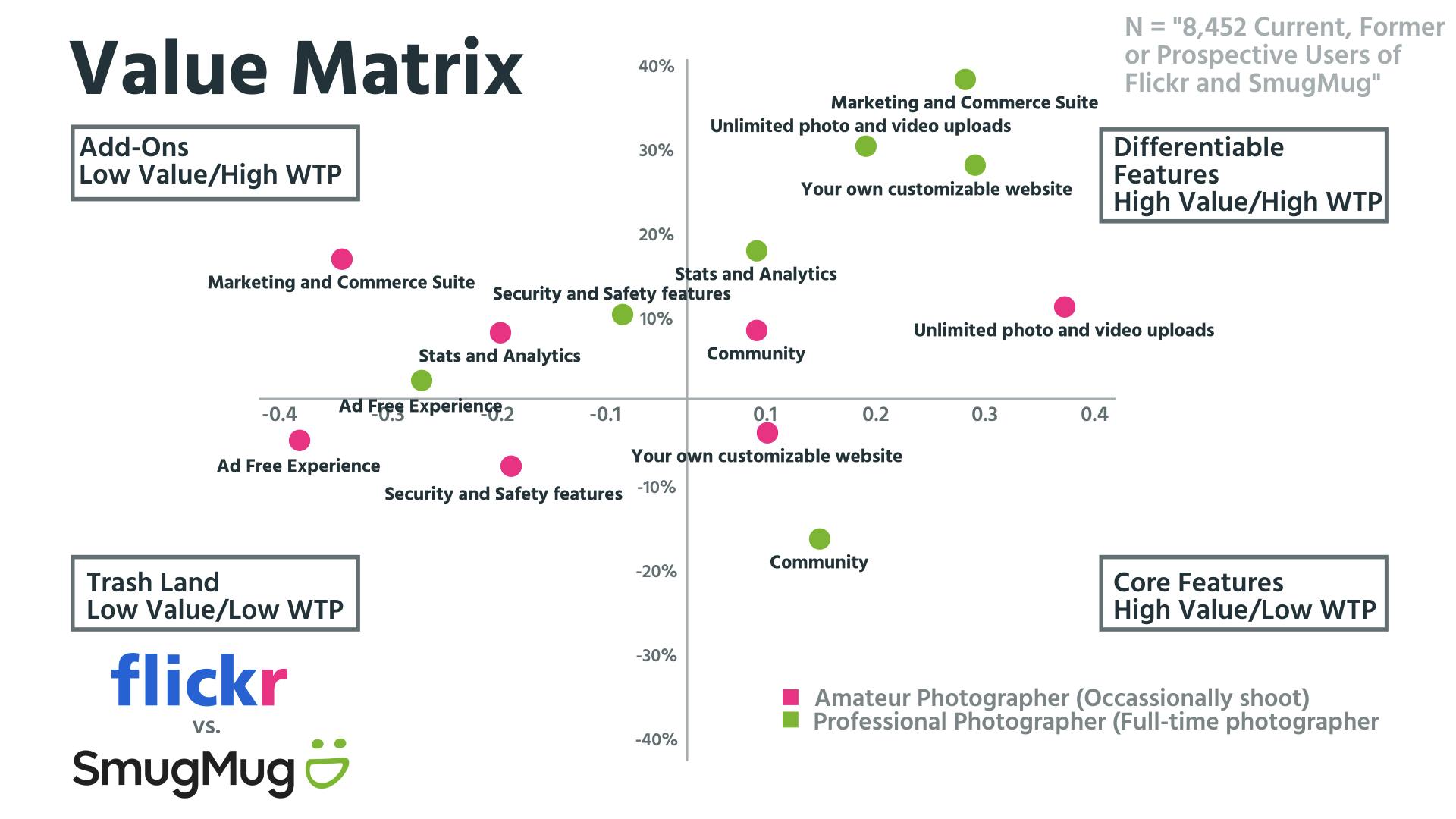With a camera in every pocket, we can all be Ansel Adams. While some of us are happy to take the odd selfie, others are making a business out of the photography boom occurring around us. And, at both ends of the market, people need a place to upload, share, and perhaps sell their work online.
This week's Pricing Page Teardown head-to-head is a little different. We've got SmugMug vs. Flickr, but as of April 2018, SmugMug owns Flickr, acquiring the photo community from Yahoo. The idea is that they will stay as separate entities serving different parts of the market. Let's dive into their pricing to understand the buyer personas of each service and where both can improve pricing to get even more photographers signed up.
SmugMug must improve the user experience of their pricing page
SmugMug knows who its customers are. It puts the buyer personas right there on the homepage:

Memory Makers, Enthusiasts, and Professionals—that is who SmugMug is for. If we were running pricing at the company, once you self-identified as one of these personas, you'd be taken through to the pricing page that shows the feature differentiation for each and guided towards the obvious plan for you. Not so at SmugMug:

When a new user clicks through the pricing page, not only do they no longer know which plan is right for them, they also don't know the difference between any of the plans. Bar the price and the value proposition for each, there is no discernible difference between the plans. What does the Power plan offer that the Basic one doesn't? If I am in the Professional buyer persona that SmugMug has created, do I need the Portfolio plan or the Business plan? As Peter says, “No Clue.”
You have to scroll down through multiple dropdowns of the Features page before you actually find any feature differentiation:

If a visitor has to take minutes to find out which plan is right for them, then they aren't going to become a customer. Even if you don't want a long-form comparison chart, having the basic feature differentiators in the initial pricing matrix or overview is a necessity. This is basic pricing page design. It makes for a better user experience for your prospective customer and is going to convert visitors better. It is a win for everybody.
Hopefully, now they are part of the same company, SmugMug can steal some of Flickr's pricing page designers:

Not only is the pricing simple—Free, Monthly, or Annual—but the pricing design is easy to understand. A new user would click on one of those options in a tenth of the time it would take them on SmugMug. It is obvious what you get with each plan, and the design guides you towards the right decision for you.
What is most interesting about Flickr's pricing is the Annual plan. For most pricing plans, an annual plan offers exactly the same as a monthly plan, but usually with a small discount as an incentive to get people into the higher retention annual plan. Flickr takes this one step further, sweetening the deal with discounts not just to the Flickr product but to other products that serious photographers would find useful.
How SmugMug and Flickr can take advantage of both ends of the market
Both companies are making the volume play. They want to vacuum up as many users at the bottom end of the market that they are neglecting proper pricing for higher tiers.
When we asked 8,452 current, former, or prospective users of Flickr and SmugMug about their willingness to pay for such a service, we saw that these services are woefully underpriced at the higher level:

This is most obvious for SmugMug as it has tiers that should span the entire range of possible users. Prosumer and Professional photographers both have a willingness to pay above the price points of the Portfolio and Business tiers that are supposed to be geared towards them. Our data also showed that there is growth within these segments:

Point and shoot hoot camera sales are tanking. We all have superior cameras in our pockets. But premium camera sales are still increasing. Photography is now embedded in our everyday lives, and once you learn how to take great photos on your iPhone, you want to level up to a DSLR. When you do, you want storage online and the opportunity to show them off.
This means that more and more people are willing to pay for the higher-end services and not just basic online photo storage (which comes free with Google and Facebook and Apple anyway). Because this end of the market is growing and because the data shows that people are willing to pay a high amount for these services, SmugMug and Flickr could increase pricing on higher plans while keeping lower plans where they are, improving retention and monetization without sacrificing acquisition.
Annual can increase ARPU but discounts will destroy it
The same trend in willingness to pay is seen at the annual level:

Just as with monthly plans, SmugMug could be taking advantage of a higher willingness to pay with annual plans. But its pricing is again being pulled down. This time, however, it is the use of discounts that are shifting the pricing lower. SmugMug offers a 29% discount on the Business plan, which brings the price of that plan down to $359.88/year. The median willingness to pay for this buyer persona is $444.87, meaning that SmugMug is missing out on $84.99 per customer each year because of its discount.
Some discount is expected for annual plans. You want cash upfront and incentivizing customers works. But our data shows that the importance of a discount diminishes as plan size increases:

In fact, more people would choose the Business plan with a 15% discount than a 35% discount. The full price of the Business plan, when paid monthly, comes out to $503.88/year. If SmugMug offered a 15% discount instead of its 29% discount, the annual price would be $428.30, an ARPU increase of over $68 per year per customer. That is a big change for such a quick and easy pricing fix.
One thing SmugMug is getting right is packaging (as difficult as it is to find). When we look at what features professional customers value, they fit in with what SmugMug offers in its Business plan:

The features this plan is differentiating on is marketing options and analytics. Amateur photographers don't care about those features. They want the community and the storage, both of which come as standard with the lower tiers.
A lot of room for improvement
SmugMug obviously wants to succeed in this space. It has bought Flickr to appeal to as many photographers as possible. But it has three massive improvements to make before it can really start to own online photography:
- Design. It is actively increasing friction at the conversion stage of its funnel. It needs to simply show what each plan has to offer and get people signed up.
- Better pricing understanding. It is leaving money on the table at the higher end. SmugMug, and to a lesser extent Flickr, is in a position to significantly increase pricing on the customers who value the product the most without hurting acquisition. It should up those prices and offer them value.
- Better discounting. Even before that though, it can just switch out its annual discount for something lower and increase ARPU today.




